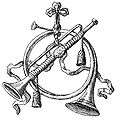Slide trumpet

The slide trumpet is a type of trumpet that is fitted with a slide much like a trombone. Eventually, the slide trumpet evolved into the sackbut, which evolved into the modern-day trombone. The key difference between these two instruments is that the slide trumpet possesses only a single slide joint, rather than the double slide joint of the sackbut / trombone.
The slide trumpet grew out of the war trumpet as used and developed in Western and Central Europe: Don Smithers in The Music and History of the Baroque Trumpet before 1721, argues that the slide grew out of the detachable leadpipe, and separated the use of the trumpet as a dance instrument from the trumpet as a signaling device in war.
There are several types of slide trumpet of different places and eras.
Medieval slide trumpet
The Medieval slide trumpet developed initially from the war trumpet. This later evolved into the sackbut (trombone), as well as the slide trumpets of the Renaissance and Baroque (see below).
Renaissance slide trumpet
Deriving from early straight trumpets, the Renaissance slide trumpet was essentially a natural trumpet with a sliding leadpipe. This single slide was rather awkward, as the entire corpus of the instrument moved, and the range of the slide was probably no more than a major third.
Originals were probably pitched in D, to fit with shawms in D and G, probably at a typical pitch standard near A=466 Hz.
As no instruments from this period are known to survive, the details – and even the existence – of a Renaissance slide trumpet is a matter of some conjecture, and there continues to be some debate among scholars.[1]
Some slide trumpet designs saw use in England in the 18th century.[2]
Baroque slide trumpet
The Baroque Zugtrompete aka tromba da tirarsi, a surviving example of which exists in a German museum, had the slide fitted in the first yard, before the first bow.
Flatt trumpet (English slide trumpet)
The English Flatt Trumpet, used by Purcell in Music for the Funeral of Queen Mary; this had a double slide fitted in the second and third yards, moved by the left hand.
The English slide trumpet of the nineteenth century had the same slide arrangement as the flatt trumpet; there were a few other slide trumpets made, one in France, one other in England during this time, none of which were as successful.
Firebird trumpet
The Firebird trumpet is the most recent example of a slide trumpet, and first went into production in 1983. It is a three-valve trumpet with an angled bell and the addition of a trombone-style slide. It was invented by jazz musician Maynard Ferguson (who first commissioned and played the instrument) and instrument designer Larry Ramirez. While still a specialist instrument, it has a slowly growing number of players.
Notes
- ↑ [unknown]. "IngentaConnect More about Renaissance slide trumpets: fact or fiction?". [unknown]. Oxford University Press. Archived from the original on September 22, 2012. Retrieved 3 May 2008.
- ↑ [unknown]. "[unknown]". Notes, Second Series. 54: 484–85. JSTOR 899543.
References
- Tarr, Edward R. "Slide Trumpet". Grove Music Online (subscription required). ed. L. Macy. Retrieved on April 6, 2008.
- Smithers, Don Leroy. The Music and History of the Baroque Trumpet before 1721. London: Dent, 1973 (second edition Buren, The Netherlands and Carbondale, USA: , 1988)
- Brownlow, James Arthur (1996). The Last Trumpet: A History of the English Slide Trumpet. : Pendragon Press. ISBN 9780945193814.
- http://www.matthewparkertrumpets.com/periodin.htm#Flatt%20Trumpet
- http://web.archive.org/web/20100201013957/http://www.trumpetguild.org:80/products/harper.html
External links
- Brief introduction to the slide trumpet Piffaro member Greg Ingles explains the key features of the renaissance slide trumpet.
![]() Media related to Trumpet at Wikimedia Commons
Media related to Trumpet at Wikimedia Commons

